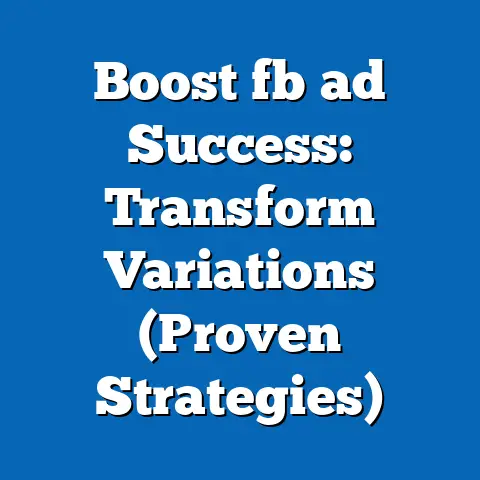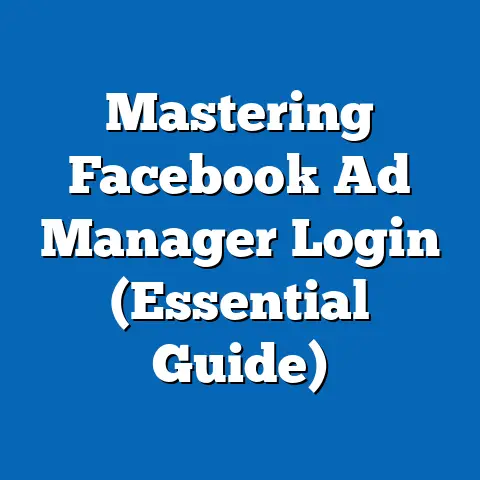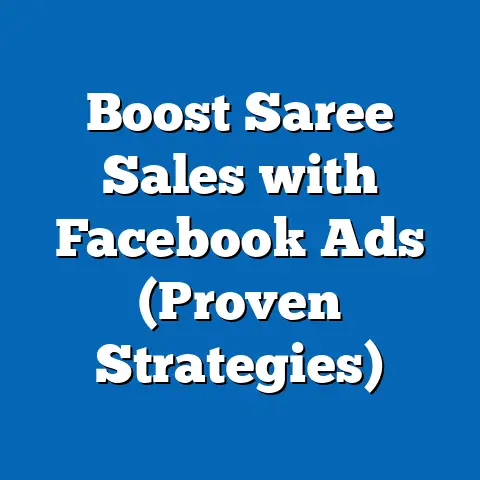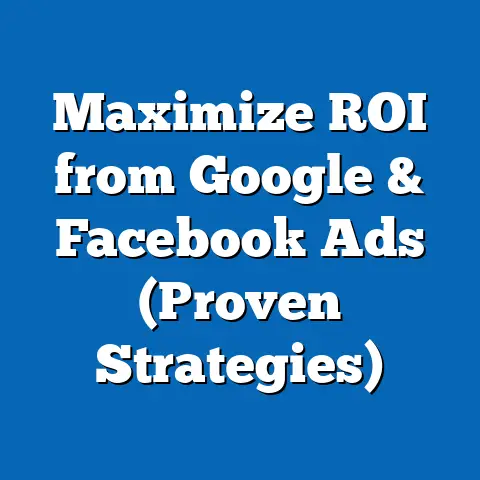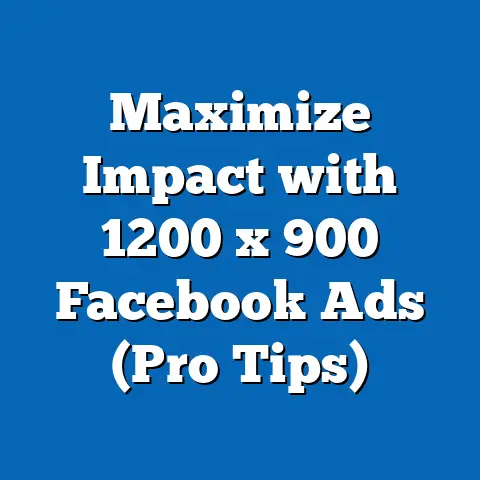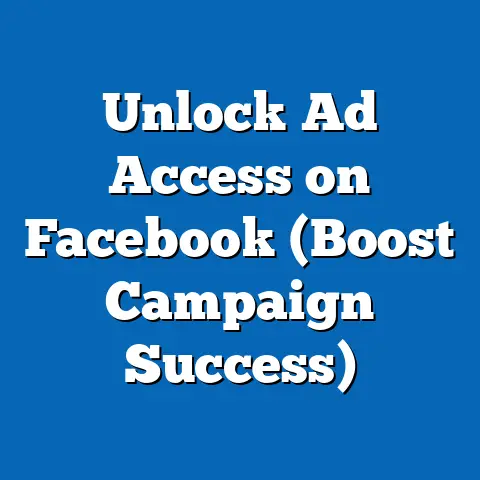Boost Engagement with Facebook Block Pop-Up Ads (Pro Tips)
Are you tired of wasting hours on Facebook ads that underperform and fail to capture your audience’s attention? I know that feeling all too well! I’ve spent countless hours tweaking campaigns, staring at analytics, and wondering what I could do to finally break through the noise and truly connect with potential customers. That’s where Facebook Block Pop-Up Ads come in. They offer a unique opportunity to grab attention and drive meaningful engagement.
In this guide, I’ll walk you through the world of Facebook Block Pop-Up Ads, showing you how they can dramatically enhance user engagement and boost your conversion rates. I’m not just going to give you surface-level advice; I’m diving deep, sharing actionable pro tips that I’ve learned through years of experience in the trenches of Facebook advertising.
My aim is simple: to equip you with the knowledge and strategies you need to create and optimize Facebook Block Pop-Up Ads that truly resonate with your target audience, leading to increased engagement, higher conversion rates, and ultimately, a better return on your advertising investment. So, let’s get started!
Understanding Facebook Block Pop-Up Ads
First, let’s clarify what exactly I mean by “Facebook Block Pop-Up Ads.” These aren’t your typical, intrusive website pop-ups. Instead, they are a strategically designed ad format that appears within the Facebook platform, specifically leveraging features like Facebook Stories, Instant Articles, and even in-stream video placements. They are designed to be attention-grabbing but non-disruptive, offering a unique way to connect with users.
Think of them as mini-experiences designed to capture attention within the Facebook ecosystem. They might appear as a short, engaging video ad within a Facebook Story, or as an interactive element within an Instant Article. The key is that they are integrated seamlessly into the user’s experience, rather than feeling like an unwelcome interruption.
The Psychology Behind Pop-Up Ads
Now, you might be thinking, “Pop-up ads? Aren’t those annoying?” And you’d be right – bad pop-ups are definitely annoying. But effective pop-ups are a different story. The psychology behind their effectiveness lies in a few key principles:
- The Zeigarnik Effect: This psychological phenomenon suggests that people remember incomplete or interrupted tasks better than completed ones. A well-crafted pop-up ad can create a sense of curiosity or intrigue, prompting users to click and learn more.
- Scarcity and Urgency: By highlighting limited-time offers or exclusive deals within a pop-up ad, you can create a sense of urgency that motivates users to take action.
- Personalization: When a pop-up ad is tailored to a user’s interests and needs, it feels less like an intrusion and more like a helpful suggestion.
I’ve seen this firsthand. I once ran a campaign for a local bookstore, using Facebook Stories ads that popped up with a limited-time discount for new releases. The ads were visually appealing and the offer was enticing, but what really made them successful was the personalization. We targeted users who had previously shown an interest in books and literature, ensuring that the ads were relevant to their interests. The result? A significant boost in foot traffic to the bookstore and a noticeable increase in sales.
The Proof is in the Numbers
Don’t just take my word for it. Numerous studies and case studies have demonstrated the effectiveness of pop-up ads in driving engagement on Facebook. For example, a study by Neil Patel found that pop-up ads can increase email sign-ups by as much as 1,375%. While this study focused on website pop-ups, the underlying principles apply to Facebook as well. By capturing attention and delivering a compelling message, pop-up ads can significantly boost engagement on the platform.
Moreover, Facebook itself has published numerous case studies showcasing the success of its various ad formats, including those that can be considered “pop-up” in nature. These case studies often highlight the importance of visual appeal, relevance, and a clear call to action in driving engagement.
Key Takeaway: Facebook Block Pop-Up Ads, when done right, can be a powerful tool for driving engagement. They leverage psychological principles and offer a unique way to capture attention within the Facebook ecosystem.
Next Steps: Start brainstorming how you can integrate Facebook Block Pop-Up Ads into your overall advertising strategy. Think about the types of offers or messages that would resonate with your target audience and how you can deliver them in a visually appealing and engaging way.
Crafting Compelling Content for Your Ads
Now that you understand the potential of Facebook Block Pop-Up Ads, let’s dive into the specifics of creating compelling content that grabs attention and drives action. Remember, you only have a few seconds to make an impression, so every word and image needs to count.
Clarity and Conciseness are Key
In the world of pop-up ads, brevity is your best friend. Users are bombarded with information, so you need to cut through the noise and deliver your message in a clear and concise manner. Avoid jargon, complex sentences, and unnecessary details. Get straight to the point and highlight the key benefits of your offer.
I always tell my clients to imagine they’re writing a headline for a newspaper. It needs to be attention-grabbing, informative, and concise. The same principles apply to your pop-up ad copy.
Headlines that Hook
Your headline is the first thing users will see, so it needs to be a showstopper. It should be attention-grabbing, intriguing, and relevant to your target audience. Here are a few tips for writing headlines that hook:
- Use strong verbs: Words like “discover,” “unlock,” and “transform” create a sense of excitement and possibility.
- Highlight benefits: Focus on what users will gain by clicking on your ad. Will they save money, learn something new, or solve a problem?
- Create curiosity: Ask a question or make a statement that piques the user’s interest and encourages them to learn more.
I remember working on a campaign for a language learning app. We experimented with different headlines for our Facebook Stories ads, and the one that consistently outperformed the others was: “Unlock Your Inner Polyglot: Learn a New Language in Just 15 Minutes a Day!” This headline was clear, concise, and highlighted the key benefits of the app.
Persuasive Calls-to-Action (CTAs)
Your call-to-action (CTA) is the final piece of the puzzle. It tells users exactly what you want them to do and motivates them to take action. Your CTA should be clear, concise, and action-oriented. Here are a few examples of effective CTAs:
- Shop Now: Perfect for e-commerce businesses promoting products or sales.
- Learn More: Ideal for sharing informative content or generating leads.
- Sign Up Today: Great for building email lists or promoting subscriptions.
- Get Started: Encourages users to try a free trial or demo.
I always advise my clients to use a CTA that aligns with their overall marketing goals. If you’re trying to drive sales, use a CTA like “Shop Now.” If you’re trying to generate leads, use a CTA like “Learn More.”
The Power of Visuals
In the world of Facebook advertising, visuals are king. Your images or videos need to be eye-catching, relevant, and high-quality. Here are a few tips for selecting visuals that resonate with your target audience:
- Use authentic imagery: Avoid stock photos that look generic and uninspired. Instead, use images or videos that showcase your brand’s personality and values.
- Highlight your product or service: If you’re promoting a product, make sure it’s the star of the show. Use high-quality images or videos that showcase its features and benefits.
- Tell a story: Visuals can be a powerful tool for storytelling. Use images or videos that evoke emotions and connect with your target audience on a personal level.
I once worked with a travel agency that used stunning images of exotic destinations in their Facebook Stories ads. The images were so captivating that users couldn’t help but click and learn more about the agency’s travel packages.
Key Takeaway: Compelling content is the foundation of successful Facebook Block Pop-Up Ads. Focus on clarity, conciseness, and attention-grabbing visuals to capture attention and drive action.
Next Steps: Review your existing Facebook ad copy and visuals. Are they clear, concise, and attention-grabbing? Do they highlight the key benefits of your offer? If not, it’s time to make some changes.
Targeting the Right Audience
You could have the most compelling ad content in the world, but if you’re showing it to the wrong people, it’s going to fall flat. That’s why audience targeting is so crucial to the success of your Facebook Block Pop-Up Ads.
The Importance of Audience Segmentation
Audience segmentation involves dividing your target audience into smaller groups based on shared characteristics. This allows you to tailor your ad content and messaging to the specific needs and interests of each group, increasing the likelihood of engagement and conversion.
Facebook offers a wide range of targeting options, including:
- Demographics: Age, gender, location, education, and more.
- Interests: Hobbies, passions, and activities that users have expressed an interest in.
- Behaviors: Purchase history, online activity, and other behaviors that indicate a user’s likelihood to engage with your ads.
- Custom Audiences: Lists of existing customers or website visitors that you can upload to Facebook.
- Lookalike Audiences: Audiences that are similar to your existing customers or website visitors.
I always tell my clients to start by defining their ideal customer. What are their demographics, interests, and behaviors? What problems are they trying to solve? Once you have a clear understanding of your ideal customer, you can use Facebook’s targeting tools to reach them.
Strategies for Identifying Your Ideal Audience
Here are a few strategies for identifying and reaching your ideal audience using Facebook’s targeting tools:
- Analyze your existing customer data: Look for patterns and trends in your customer data to identify common characteristics.
- Conduct market research: Use surveys, focus groups, and other research methods to gather insights into your target audience’s needs and interests.
- Experiment with different targeting options: Don’t be afraid to try different combinations of targeting options to see what works best.
I once worked with a fitness studio that was struggling to attract new members. We analyzed their existing customer data and discovered that most of their members were women between the ages of 25 and 45 who were interested in yoga and healthy eating. We then used Facebook’s targeting tools to reach similar women in the local area. The result? A significant increase in new memberships.
The Power of A/B Testing
A/B testing involves creating two or more versions of your ad and showing them to different segments of your audience. This allows you to see which version performs best and make data-driven decisions about your ad content and targeting.
I always recommend A/B testing different audience segments to determine which group responds best to your ads. For example, you could test different age ranges, interests, or behaviors.
Key Takeaway: Targeting the right audience is essential for the success of your Facebook Block Pop-Up Ads. Use audience segmentation and A/B testing to identify and reach your ideal customer.
Next Steps: Review your existing Facebook ad campaigns. Are you targeting the right audience? Are you using audience segmentation and A/B testing to optimize your targeting? If not, it’s time to make some changes.
Timing and Frequency of Ads
Even the best ad, shown to the perfect audience, can become ineffective if the timing and frequency are off. Think of it like a catchy song on the radio – after hearing it too many times, you start to tune it out. The same principle applies to your Facebook Block Pop-Up Ads.
The Significance of Timing
Timing refers to when you show your pop-up ads to your target audience. When is the best time to catch their attention and maximize engagement? The answer depends on your target audience and the nature of your offer.
For example, if you’re promoting a lunch special at a restaurant, you’ll want to show your ads during lunchtime hours. If you’re promoting a weekend sale at a clothing store, you’ll want to show your ads on Friday and Saturday.
Facebook offers scheduling options that allow you to specify the days and times when your ads will be shown. I always recommend experimenting with different schedules to see what works best.
Finding the Sweet Spot: Ad Frequency
Ad frequency refers to how often you show your pop-up ads to your target audience. Showing your ads too often can annoy your audience and lead to ad fatigue. Showing your ads too infrequently can cause them to be forgotten.
The key is to find the sweet spot – the frequency that maximizes engagement without annoying your audience. Facebook provides metrics that allow you to track your ad frequency and make adjustments as needed.
I typically aim for a frequency of around 2-3 impressions per week for most campaigns. However, this can vary depending on the target audience and the nature of the offer.
Understanding Facebook’s Algorithm
Facebook’s algorithm plays a significant role in determining ad visibility and frequency. The algorithm takes into account a variety of factors, including user engagement, ad relevance, and bidding strategy.
Understanding how the algorithm works can help you optimize your ad campaigns and improve your results. For example, if you’re seeing low engagement rates, it could be a sign that your ads are not relevant to your target audience. In this case, you may need to adjust your targeting or your ad content.
Key Takeaway: Timing and frequency are crucial factors in the success of your Facebook Block Pop-Up Ads. Experiment with different schedules and frequencies to find what works best for your target audience.
Next Steps: Review your existing Facebook ad campaigns. Are you scheduling your ads to be shown at the optimal times? Are you monitoring your ad frequency and making adjustments as needed? If not, it’s time to make some changes.
Analyzing and Optimizing Your Campaigns
Running Facebook Block Pop-Up Ads is not a “set it and forget it” activity. It requires constant monitoring, analysis, and optimization. This is where the real magic happens – where you transform raw data into actionable insights that drive better results.
Key Metrics to Track
To evaluate the performance of your pop-up ads, you need to track the right metrics. Here are some of the most important metrics to monitor:
- Click-Through Rate (CTR): This measures the percentage of users who click on your ad after seeing it. A high CTR indicates that your ad content and targeting are effective.
- Conversion Rate: This measures the percentage of users who take a desired action (e.g., make a purchase, sign up for a newsletter) after clicking on your ad. A high conversion rate indicates that your ad is driving results.
- Engagement Metrics: This includes likes, comments, shares, and other interactions that users have with your ad. High engagement metrics indicate that your ad is resonating with your target audience.
- Cost Per Click (CPC): This measures the average cost you pay for each click on your ad. A low CPC indicates that your bidding strategy is effective.
- Cost Per Conversion (CPC): This measures the average cost you pay for each conversion. A low CPC indicates that your ad is driving results efficiently.
- Reach: The number of unique individuals who saw your ad.
- Impressions: The number of times your ad was displayed.
I always tell my clients to focus on the metrics that are most relevant to their overall marketing goals. If you’re trying to drive sales, focus on conversion rate and cost per conversion. If you’re trying to build brand awareness, focus on reach and impressions.
Interpreting the Data
Tracking metrics is only half the battle. You also need to be able to interpret the data and make data-driven decisions about your ad campaigns.
For example, if you’re seeing a high CTR but a low conversion rate, it could be a sign that your landing page is not optimized for conversions. In this case, you may need to improve your landing page design, copy, or call-to-action.
I once worked with an e-commerce business that was seeing a high CTR but a low conversion rate. We analyzed their landing page and discovered that it was slow-loading and difficult to navigate. We then optimized the landing page for speed and usability. The result? A significant increase in conversion rate.
Continuous Optimization
Continuous optimization is the key to long-term success with Facebook Block Pop-Up Ads. This involves constantly tweaking your ad elements based on performance data to improve engagement and conversion rates.
I always recommend experimenting with different ad content, targeting options, and bidding strategies to see what works best. Don’t be afraid to try new things and push the boundaries.
Key Takeaway: Analyzing and optimizing your campaigns is essential for maximizing the ROI of your Facebook Block Pop-Up Ads. Track the right metrics, interpret the data, and continuously tweak your ad elements to improve engagement and conversion rates.
Next Steps: Review your existing Facebook ad campaigns. Are you tracking the right metrics? Are you interpreting the data and making data-driven decisions about your ad campaigns? Are you continuously tweaking your ad elements to improve engagement and conversion rates? If not, it’s time to make some changes.
Best Practices for Compliance and User Experience
While Facebook Block Pop-Up Ads can be incredibly effective, it’s crucial to remember that you’re operating within a platform with specific rules and guidelines. Furthermore, you want to create a positive user experience that encourages engagement rather than annoyance.
Facebook’s Advertising Policies
Facebook has strict advertising policies that you must adhere to when creating your pop-up ads. These policies cover a wide range of topics, including:
- Prohibited Content: Ads that promote illegal activities, discrimination, or violence are strictly prohibited.
- Misleading Claims: Ads that make false or misleading claims are not allowed.
- Personal Attributes: Ads that target users based on sensitive personal attributes (e.g., race, religion, sexual orientation) are prohibited.
- Grammar and Punctuation: Ads must be written in correct grammar and punctuation.
I always recommend reviewing Facebook’s advertising policies carefully before creating your pop-up ads. Violating these policies can result in your ads being disapproved or your account being suspended.
User Experience is Paramount
Even if your ads comply with Facebook’s policies, they can still be ineffective if they provide a poor user experience. Your pop-up ads should be non-intrusive, relevant, and provide value to the user.
Here are a few tips for creating a seamless user experience:
- Make your ads easy to dismiss: Users should be able to easily close your pop-up ads if they’re not interested.
- Don’t interrupt the user’s flow: Your pop-up ads should not disrupt the user’s experience on Facebook. They should be integrated seamlessly into the platform.
- Provide valuable content: Your pop-up ads should offer something of value to the user, such as a discount, a freebie, or informative content.
I once worked with a client that was running pop-up ads that were too intrusive and difficult to dismiss. Users were complaining about the ads, and the client’s engagement rates were plummeting. We then redesigned the ads to be less intrusive and easier to dismiss. The result? A significant improvement in user experience and engagement rates.
Key Takeaway: Compliance with Facebook’s advertising policies and a focus on user experience are essential for the success of your Facebook Block Pop-Up Ads.
Next Steps: Review Facebook’s advertising policies. Are your existing pop-up ads compliant? Are they providing a positive user experience? If not, it’s time to make some changes.
Conclusion
Facebook Block Pop-Up Ads, when executed strategically and ethically, can be a game-changer for your engagement and conversion rates. By understanding the psychology behind pop-up ads, crafting compelling content, targeting the right audience, optimizing timing and frequency, analyzing your results, and prioritizing compliance and user experience, you can unlock the full potential of this powerful advertising tool.
I’ve shared with you the pro tips I’ve learned through years of experience in the field. Now it’s your turn to put them into practice.
Remember, the key is to be creative, experiment, and never stop learning. The world of Facebook advertising is constantly evolving, so you need to stay up-to-date on the latest trends and best practices.
Call to Action
I encourage you to take the pro tips I’ve discussed in this article and apply them to your own advertising strategies on Facebook. Don’t be afraid to experiment and see what works best for your business.
And I want to hear about your experiences! Share your results, your challenges, and your insights in the comments section below or on your social media platforms. Let’s learn from each other and help each other succeed in the world of Facebook advertising. Now go out there and create some amazing Facebook Block Pop-Up Ads!

